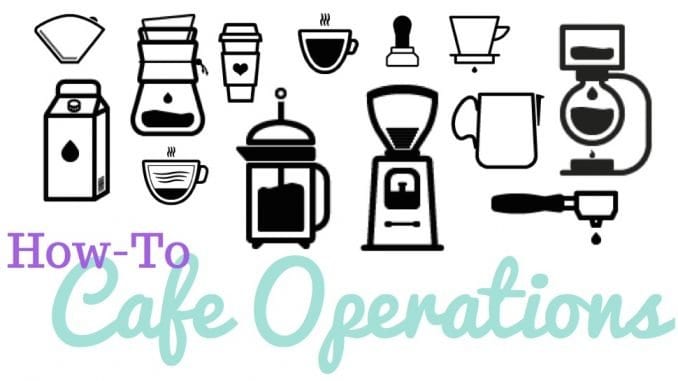
BY ASHLEY RODRIGUEZ
SPECIAL TO BARISTA MAGAZINE
In the latest Barista Magazine blog series, our online editor Ashley Rodriguez will explain ˜how to’ identify and implement different tools and strategies to help your café run as efficiently as possible. You can learn more about the series and read part one here.
In chemistry, there’s a term called ˜limiting reagents.’ If you took a chemistry class, you’ve probably heard these words when balancing chemical equations. A limiting reagent is essentially a compound that stops a chemical reaction ”once you run out of it, the reaction ends, and you can’t create any more of a product. For example, if you have 8 carbon molecules and 20 oxygen molecules hanging out and combining to make CO2, carbon is the limiting reagent because you can only make 8 CO2 compounds before you run out of carbon. If you’re normal, you probably hated this part of chemistry class because it involved a lot of algebra and it’s honestly pretty useless and you might even be mad at me for reminding you of this.
If you’re me, this was the most exciting part of chemistry class because I love putting things together and consolidation, and balancing chemical equations was the nerdiest expression of that. And I also think this idea of balancing equations and limiting reagents can also apply to the café. Let’s say for a perfect transaction with a customer, you need a couple of elements correctly in the right place to have everything run smoothly:
x + y + z = perfect transaction with a customer
Ideally, for a perfect morning service, this equation keeps repeating itself over and over again without pause. It’s these transactions, happening over and over, that make you money and ensure the livelihood of the café. A limiting reagent, in this situation, would be any item that stops the process. It’s anything that a barista has to do that disrupts service, but needs to be done in order for the café to work. In this installment of my how-to series, I’ll point out some common limiting reagents and how you can easily avoid them to ensure a smooth and seamless coffee service designed to maximize customer interactions.
- Identify limiting reagents.
The worst thing that can happen during a busy morning rush is for service to stop. So identify the things that can halt the line and require attention. One thing that most cafes provide is a condiment station for patrons to fix up their drinks. If you run out of lids in the middle of a busy rush, that stops service ”someone has to stop what they’re doing and attend to that because most customers aren’t going to leave without demanding a lid. In this situation, the lids are your limiting reagent. So I always anticipate this by stocking the lids as high as I can before a morning rush. And usually, your condiment station is usually the area with the most limiting reagents.
Common limiting reagents I see in most cafes: milk carafes that need to be filled (anticipate before a rush or have a second one ready to switch out), ice running out (buy more ahead of time), stirring spoons that are dirty and need to be washed (buy a zillion spoons), trashes filling up and needing to be replaced (buy a second trash bin). All these things can help a line move faster because your baristas can concentrate solely on maximizing transactions and getting people everything they need without pause.
- Anticipate the needs of your customers, and make things easy when possible.
Something I never appreciated the genius of is rounding up prices to the closest quarter. Not only does it make counting the register easier for your baristas, but it makes transactions between baristas and customers simple and fast. A customer fishing for four pennies is going to take longer than one pulling out a quarter, and people are also much happier getting back their change in quarters as opposed to pennies and nickels.
Another need most customers have is water, which makes sense since we serve a drink that can dehydrate our clients. However, let’s say one out of every ten customers asks for water, and your baristas have to stop what they’re doing to make that happen. A solution? Water spigots with cups that customers can serve themselves. Obviously this solution requires building something new for your café, but there are plenty of other ways you can respond to the needs of your patrons without distracting baristas and making transactions easier.
- Know your store and its busy times.
If you use some sort of register software to take cash and credit, you can probably see what times of day your store is busiest. Using my café as an example, I know that I am going to be slammed between 8:00-10:00 (and I’d guess that’s true for most cafes). So that 7:00-8:00 hour is my prep time. It’s when I do my side work, it’s when I ensure that the condiment station is stocked, and it’s when I try to make my life as easy as possible: I’ll take out all the milks we have and put them by the espresso machine, I’ll cut open a five pound bag of espresso to make sure I’m not ripping and tearing into a new bag to fill the hopper, and I’m checking iced coffee to make sure I have enough mixed and ready to go.
Think of the times before your café gets busy as times to do your mise en place or all the prep work needed to be done short of putting a drink together. Do you have chai ready? Do you need to make more chocolate for mochas? Have you stamped cups? All this needs to happen before the café gets busy because you cannot run out of a thing a customer needs.
The point of all this is to help your café run at its optimum capacity and ring up the most people. However, you can’t do that if you don’t feel confident moving a line. Next week, we’ll talk about how to attack a line of customers and get people moving quickly.


Great read with some really interesting points. Many establishments will invest in wholesale drinks to ensure they bring a wide variety of flavours to their customers.
Most shops I’ve frequented run pretty smooth, but the few that don’t are often for the reasons you cite in this series. I think customers standing in line do watch how a shop is run and make their loyalty decisions based a lot of how the shop respects their patronage and time. I’d put the proactive steps you outline right up there with the quality of the coffee being served and the barista/bar staff’s interaction with the customer. Call it the Holy Trinity of Coffee Shops. Efficiency, Coffee Taste and Personable-ness.